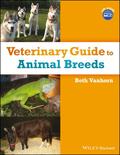Veterinary Guide to Animal Breeds

1. Auflage Juli 2017
120 Seiten, Softcover
Praktikerbuch
Der Veterinary Guide to Animal Breeds ist ein umfassendes Referenzwerk zur genauen Bestimmung von Kleintieren, exotischen Tieren und Großtieren. Farbfotos helfen bei der Identifizierung, wichtige Informationen unterstützen die veterinärmedizinische Behandlung.
- Zuverlässiger Veterinärleitfaden für die genaue Bestimmung von Rassen.
- Behandelt Kleintier-, Großtierrassen sowie Exoten.
- Bietet insbesondere Informationen für den Alltag eines Veterinärmediziners.
- Farbfotos helfen bei Vergleich und Identifizierung.
- Begleitende Website mit Lehrmaterialien, inkl. Arbeitsblätter und PowerPoint-Folien.
1 Dog Breed Identification 1
Objectives 1
1.1 Introduction 1
1.2 Characteristics of Dogs 1
1.3 Classes of Breeds 1
1.4 Summary 4
2 Cat Breed Identification 5
Objectives 5
2.1 Introduction 5
2.2 Characteristics of Cats 5
2.3 Classes of Breeds 5
2.4 Summary 8
3 Rabbit Breed Identification 9
Objectives 9
3.1 Introduction 9
3.2 Characteristics of Rabbits 9
3.3 Types of Rabbits 9
3.4 Summary 11
4 Guinea Pig Breed Identification 13
Objectives 13
4.1 Introduction 13
4.2 Characteristics of Guinea Pigs 13
4.3 Types of Guinea Pigs 13
4.4 Summary 14
5 Pocket Pet Breed Identification 15
Objectives 15
5.1 Introduction 15
5.2 Characteristics of Mice 15
5.3 Characteristics of Rats 15
5.4 Characteristics of Hamsters 16
5.5 Characteristics of Chinchillas 17
5.6 Characteristics of Hedgehogs 17
5.7 Characteristics of Gerbils 17
5.8 Characteristics of Ferrets 18
5.9 Summary 18
6 Avian Breed Identification 21
Objectives 21
6.1 Introduction 21
6.2 Characteristics of Companion Birds 21
6.3 Orders of Companion Birds 22
6.4 Summary 24
7 Reptile Species Identification 25
Objectives 25
7.1 Introduction 25
7.2 Characteristics of Reptiles 25
7.3 Types of Reptiles 26
7.4 Summary 27
8 Amphibian Species Identification 29
Objectives 29
8.1 Introduction 29
8.2 Characteristics of Amphibians 29
8.3 Types of Amphibians 29
8.4 Summary 31
9 Cattle Breed Identification 33
Objectives 33
9.1 Introduction 33
9.2 Characteristics of Cattle 33
9.3 Types of Cattle 34
9.4 Summary 35
10 Equine Breed Identification 37
Objectives 37
10.1 Introduction 37
10.2 Characteristics of Equines 37
10.3 Types of Equines 38
10.4 Summary 40
11 Swine Breed Identification 41
Objectives 41
11.1 Introduction 41
11.2 Characteristics of Swine 41
11.3 Types of Swine 41
11.4 Breeds of Swine 42
11.5 Summary 45
12 Sheep Breed Identification 47
Objectives 47
12.1 Introduction 47
12.2 Characteristics of Sheep 47
12.3 Classes of Sheep 47
12.4 Breeds of Sheep 49
12.5 Summary 52
13 Goat Breed Identification 53
Objectives 53
13.1 Introduction 53
13.2 Characteristics of Goats 53
13.3 Classes of Goats 53
13.4 Breeds of Goats 54
13.5 Summary 56
14 Poultry Breed Identification 57
Objectives 57
14.1 Introduction 57
14.2 Characteristics of Poultry 57
14.3 Classes of Poultry 57
14.4 Breeds of Poultry 60
14.5 Summary 67
15 Alternative Production Animal Breed Identification 69
Objectives 69
15.1 Introduction 69
15.2 Alternative Animal Production Systems 69
15.3 Common Alternative Production Animal Species 69
15.4 Summary 76
Appendix 77
Index
?The text was written for readers with minimal biology background. The images are clear and of good quality. The accompanying website hosts a series of teaching presentations, test questions, and breed identification worksheets to help students memorize facts?.This book will be best used as a resource in animal science classrooms or for veterinary assistants in the early stages of their careers, who want a quick reference before speaking with clients about their pets.? JAVMA, January 2018
Beth Vanhorn, AS, CVT, is Instructor in the Adult Education Veterinary Assistant Program at the Dauphin County Technical School and is a Practice Manager with the Banfield Pet Hospital in a small animal clinic in Lancaster, Pennsylvania, USA


